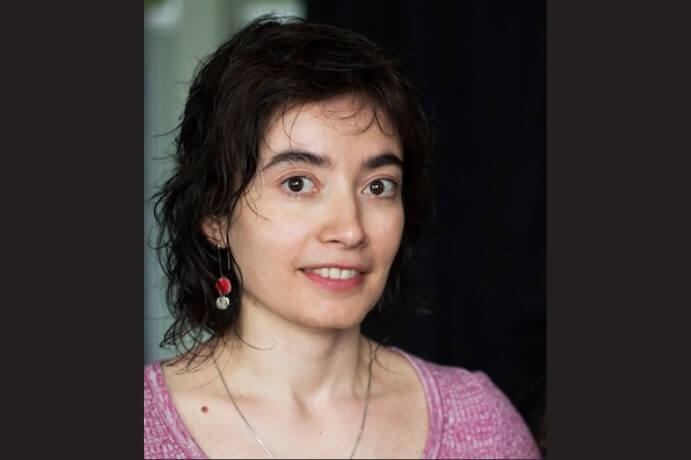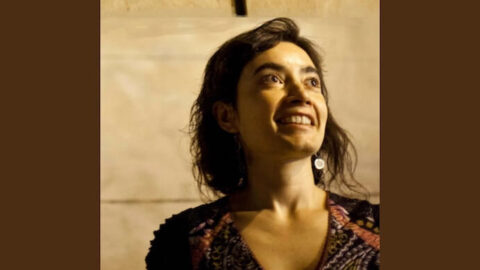This article was commissioned by American Composers Forum.
I first encountered the music of Patricia Martinez (1973-2022) about ten years ago while searching for repertoire for my ensemble. I felt immediately taken by her music and intrigued by her life path, moving comfortably between very different music scenes in South and North America and Europe. Like an expression of her Argentinian heritage, her music is an abundant mixture of influences with a generosity of emotions and an irreverence toward imposed categories or limitations. Her music transported me into a rich, coherent world of sound, powerfully honest and expansive.
When I joined American Composers Forum, I was pleased to discover that Patricia had released an album with innova Recordings in 2011. And in 2022, she was one of nine composers commissioned through Composing Inclusion, a program that supports the creation of flexible scores written by Black and/or Latina/e/o composers for multi-generational ensembles. Patricia passed away shortly after being selected for the program, and on May 12, we will pay tribute to her at the Composing Inclusion Chamber Recital with a performance of her solo piano work, Suite dedo afónica, performed by Benjamin Wien.
Patricia was a multifaceted artist who was born in Buenos Aires, Argentina, but connected with the rest of the world through her work. Her creative vision was expansive, encompassing new operatic, symphonic, and chamber works, contemporary music theater, computer music, improvisation, choreography-composition, and video art. She was a warm, intelligent, and generous person with an unparalleled work ethic. Lovingly dedicated to her art and profession, she was unafraid to reflect on the deep complexities of the human experience and to fearlessly face the challenges presented by the field of classical music.

Garnering high esteem, both personally and professionally, Patricia emerged as a prominent figure and advocate for women composers across Argentina, the United States, and Europe. Following her graduate studies at Stanford, she returned to Argentina to assume teaching positions at prestigious educational institutions in Buenos Aires, including the Conservatory of the City of Buenos Aires and the National University of Quilmes.
Patricia’s music is a metaphor for our fundamental human essence; it is an invitation to observe ourselves, to perceive our interconnectedness, and to contemplate our innate mortality – an intrinsic and essential part of our human life – as a means of radically transforming our sense of self and our purpose. Her notation is masterfully crafted, guiding performers through the poetics of her ideas. Her scores and staging are constructed with intricate layers of both literal and figurative elements that aim to forge a fresh significance, something she called “the impossible.” Her written instructions in the parts are created to evoke a specific state of mind in the performers. And the audience is similarly guided through a multidimensional experience by the various visual extensions of her music, including accompanying video projections, interactive lighting, and choreography.
During my recent trip to Argentina, I spoke with Marcelo Delgado, an Argentinian composer and the founder and director of the Compañía Oblicua. He described Patricia’s notation style as alternating “precise technical instructions about the production of the desired sound with others of a metaphorical nature (‘like stopping time, like stopping a rampant horse,’ ‘as if the artist tried, and failed,’ or ‘with the natural irregularity of an internal conversation’).”
Patricia understood notation as a bureaucratic aspect of the profession, something that required considerable effort, but was nonetheless essential for communicating her vision to others performing her work in distant places. She used multiple instructions, layering conventional and personal means of notation to connect with the conductor and the performer. Delgado describes her scores as “manifesting an expressive interiority that overflows the usual channels of interpretative margins,” transforming objective notation into something subjective, a personal signature and expression of her artistic ideas.
Patricia often viewed her creative journey as a relentless pursuit of the impossible: integrating sound and vision, creating multidimensional works that defy categorization, and inviting audiences into a realm of spiritual introspection. As the artistic director and founder of Compañía Helada, she was at the forefront of shaping the future of new opera. In pieces like Short Sleep and The Frozen Little Girl, she delves into the depths of the subconscious, exploring themes of mortality, vulnerability, and the search for meaning in an impermanent world.
Patricia didn’t consider herself a multimedia artist because she believed that artistic creation could not be confined to a single mode of expression. To her, composing transcended the boundaries of any one medium. She acknowledged music’s inherent connection to external factors, even when solely focused on composing sounds – though she felt that we are never just thinking about sounds when composing. Even in absolute music with no objective meaning, that acoustic experience happens in a particular space. That space has its own independent story, and the audience brings their own sensorial and psychological predispositions. Patricia believed a composer must consider the experience they are creating for the audience; therefore, composing exceeds the idea of one medium.
Patricia saw contemporary composers as mirrors of society and urged them to be conscious composers, understanding that as an essential part of the profession. Composers are often just taught how to write down ideas without being challenged to consider how to relate to the audience, how to relate to a collective consciousness, and the actual logistics of bringing a work to life. Although deadlines and other details of a project can limit a composer’s freedom to engage with new work, Patricia emphasized the importance of establishing a profound connection with performers, akin to embarking on a relationship; music as a means for something to happen, not as a means to an end.
As I reflect on Patricia’s journey and the impact of her music and her persona, I feel her transcendence as an artist and as a reference for Argentine women composers. She was a model of the work ethic and strength needed to overcome all the difficulties of the profession, especially those particular to gender in a historically misogynistic field. Her music deserves to be preserved and passed on. Her scores are published by Melos Ediciones, Casa de las Américas, and BabelScores, and her works appear on the record labels 80 Mundos, innova, Wergo, and Ein Klan Records.
Amidst the recognition and praise she received, Patricia remained grounded in her humanity, acknowledging the inherent challenges and uncertainties in the creative journey. She didn’t escape the fear of disappearing after death, as has happened to so many women composers in history. But music transcended a mere profession for her; it served her as a vital lifeline, imbuing her existence with purpose and significance.
I CARE IF YOU LISTEN is an editorially-independent program of the American Composers Forum, and is made possible thanks to generous donor and institutional support. Opinions expressed are solely those of the author and may not represent the views of ICIYL or ACF.
You can support the work of ICIYL with a tax-deductible gift to ACF. For more on ACF, visit the “At ACF” section or composersforum.org.
























